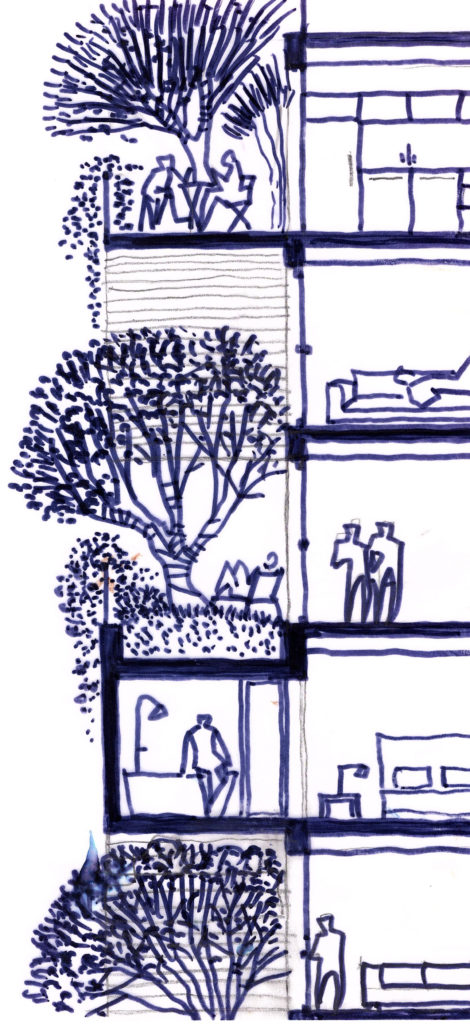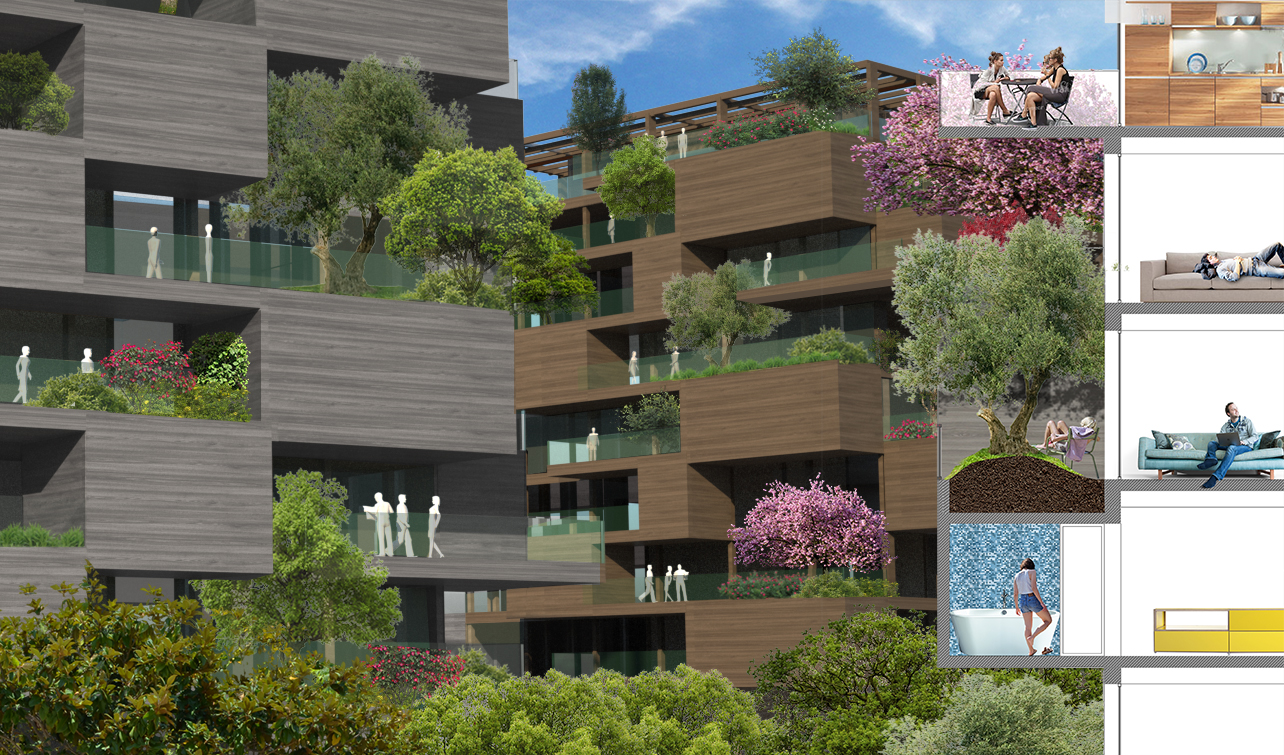L’esperienza del ‘’Bosco Verticale ‘’di Stefano Boeri che ha riscosso un successo planetario, ci ha insegnato che esiste un altro modo di immaginare il vivere urbano, attraverso un nuovo design che include una forte presenza di verde, aiutando realmente a contrastare l’inquinamento urbano, stabilendo cosi un nuovo standard qualitativo per le nostre città.
Convinti che sia la giusta direzione, e solo l’inizio di una evoluzione darviniana del vivere contemporaneo, cosa accadrebbe se… potessimo unire al verde sulle facciate degli edifici anche una rivisitazione delle nostre abitazioni, capaci di correggere quelle anomalie interne e regalare a tutti gli appartamenti un angolo di verde. Con questa idea nasce il Green Terrace System.
E’ un sistema innovativo, per la realizzazione di residenze eco-sostenibili di ultima generazione. Il progetto rappresenta una evoluzione tipologica all’ interno e all’esterno dello spazio domestico tradizionale.
Un’architettura di nuova generazione che prevede l’integrazione del verde negli edifici residenziali, realizzato attraverso l’uso intensivo del verde sulle facciate esterne degli edifici e sui tetti mediante l’uso di terrazze pensili, capaci di supportare un vero e proprio manto erboso al posto di una pavimentazione tradizionale, e la capacità di contenere arbusti cespugli e veri e propri alberi di media grandezza.
La rivisitazione della “terrazza”, peculiarità della palazzina italiana, si trasforma in un piccolo giardino pensile, naturale estensione del soggiorno, capace di accogliere quasi per la sua interezza un vero e proprio angolo di vegetazione, una piccola oasi naturale. Piantumazioni non più relegate in fioriere o vasi ma parte integrante della terrazza uno spazio dove sostare a piedi nudi sull’erba.
Ripensare la cellula abitativa dall’esterno verso l’interno, attraverso una rivoluzione del classico spazio residenziale, partendo proprio dall’area più intima della casa il ‘’Bagno’’. Il superamento di una regola consolidata che vede questo spazio un accessorio necessario ma sacrificabile, utile a coprire vuoti bui e poco areati, frutto di una scarsa immaginazione.
La “migrazione del bagno” verso l’esterno porta a sorprendenti risultati. Il primo dei quali è rappresentato da uno ‘’svuotamento’’ dello spazio abitativo interno con effetto di una maggiore flessibilità spaziale all’ interno delle singole cellule abitative, lasciando spazio alla progettazione degli interni. Non più bagni bui con areazione forzata, ma tutti con finestra, areazione naturale e accesso diretto all’esterno . La possibilità di sfruttare, il dislivello tra l’altezza minima del solaio interno del bagno, e l’altezza del solaio residenziale, produce un gap importante.
La copertura dell’intero bagno si trasforma in un grande contenitore di terra per un tetto giardino in grado di ospitare non solo un tappeto erboso ma anche piantumazioni, ed essenze di varia natura, come arbusti e alberi di media grandezza.
Questo sistema potrebbe essere allargato ad altre tipologie edilizie, come uffici, centri commerciali e spazi pubblici, una visione che permette d’ immaginare edifici avvolti da alberi e piante innescando un processo virtuoso che promuove la convivenza tra architettura e natura favorendo la creazione di nuovi ecosistemi urbani.

The experience “Bosco Verticale” of Stefano Boeri, it is get a global succsess, it’s taught us that there is another way of imagining urban living, through a new design that includes a strong presence of greenery, really helping to counteract urban pollution, establishing a new quality standard for our cities. We are convinced that it is the right direction, and only the beginning of a Darwinian evolution of contemporary living, what would happen if ?… we could work on the facades of buildings and a revisitation of our living space, able to correct those internal anomalies and give everyone the apartments a corner of greenery. With this idea the Green Terrace System is born.
Is an innovative system for the realization of eco-sustainable residences of the latest generation. The project represents a typological revolution inside and outside the traditional domestic space.
A new architecture generation that provides the integration of the green in residential buildings, achieved through the intensive use of the green on the external facades of buildings and on the roofs tops by use hanging terraces, able to support a real grass instead of a traditional pavement, and the ability to contain shrubs bushes and real trees.
The revisitation of the “terrace”, a peculiarity of the Italian building, is therefore transformed into the occasion to rethink the residential space a small hanging garden, a natural extension of the living room, capable of accommodating almost in its entirety a real corner of vegetation, a small natural oasis. Plantings no longer relegated to planters or vases but an integral part of the terrace where you can stand barefoot on the grass.
A new design that imagines the residential space from the outside towards the inside, through a revolution of the classic residential space, starting from the most intimate area of the house the ‘’ Bath ’’. Overcoming a consolidated rule that sees this space as a necessary but expendable accessory, useful to cover dark and poorly ventilated voids, the result of poor imagination.
“Bathroom migration” to the outside leads to surprising results. The first of which is represented by an “emptying” of the internal living space with the effect of greater spatial flexibility within the individual living cells, leaving space for the interior design. No more dark bathrooms with forced ventilation, but all with windows, lighting and natural ventilation and direct access to the outdoor terrace like a normal room.
The possibility of using the difference in height between the internal floor of the bathroom and the height of the residential floor produces an important gap.
It is a unique opportunity to imagine the coverage of the entire bathroom, which can still expand by adding the bathrooms or adding a walk-in closet. A large container of earth sufficient to generate a roof garden that can accommodate not only a grass but also plantings, and essences of various kinds, such as bushes and medium-sized trees.
This system could be extended to other building types, such as offices, shopping centers and public spaces, a vision that allows us to imagine buildings surrounded by trees and plants, triggering a virtuous process that promotes coexistence between architecture and nature, favoring the creation of new urban ecosystems.
Tipologia: prototipo residenziale
Luogo: Roma
Anno: 2016 – work in progress
Team: Valerio Cruciani, Federica Cecchi, Angelica Runkel, Marta giannini.


